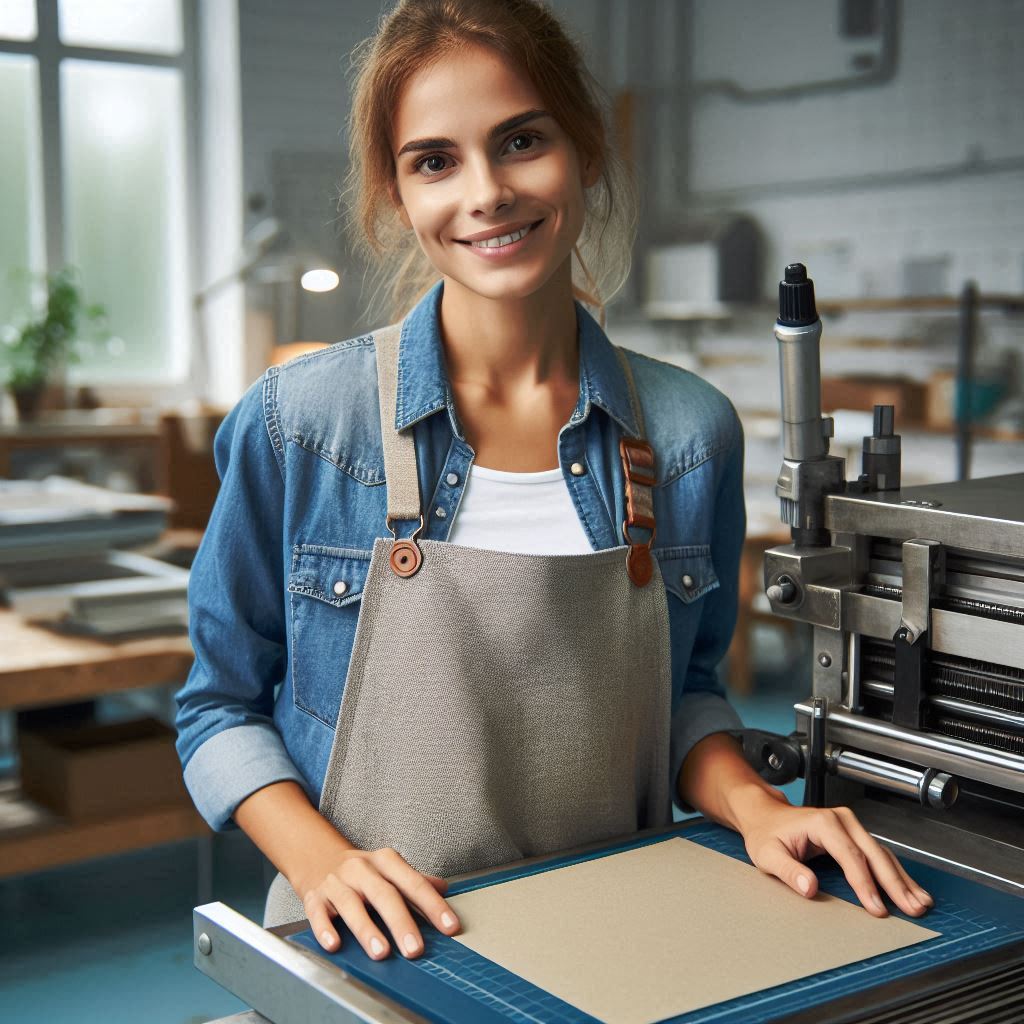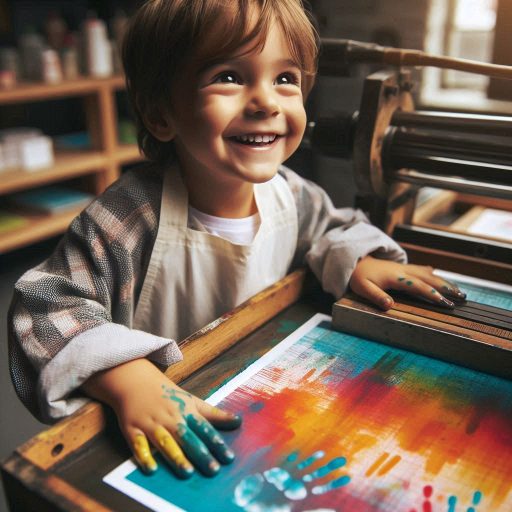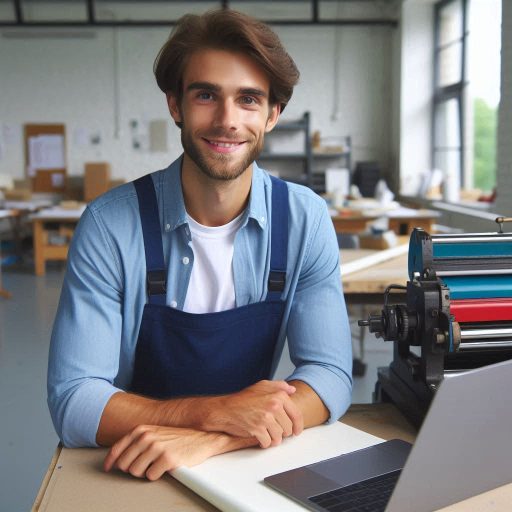Introduction
Setting up a printmaking studio is crucial for artists looking to hone their craft.
A dedicated space allows for uninterrupted focus and creativity.
It also provides the proper environment for storing tools, materials, and prints safely.
Having a studio designed for printmaking helps streamline the workflow, making the process smoother and more efficient.
When artists work in a space specifically arranged for their needs, they can focus solely on their art.
A well-organized studio reduces distractions and enhances productivity, enabling artists to produce higher-quality prints.
Additionally, it allows for better control over the entire printmaking process, from preparing the materials to the final print.
Investing time in organizing a printmaking studio also helps minimize mistakes.
Artists can find their tools easily and maintain a cleaner workspace.
This leads to more precise work and fewer disruptions during the creative process.
In summary, setting up a printmaking studio offers numerous benefits.
It creates a conducive environment for creativity, boosts efficiency, and allows artists to work at their best.
Determine Your Space
Assess the available space and layout to determine the best location for your printmaking studio
When setting up a printmaking studio, the first and most crucial step is to determine the space where you will be working.
It’s essential to assess the available space and layout to find the most suitable location for your studio.
Consider natural light, ventilation, and proximity to necessary utilities
Consider factors such as natural light, ventilation, and proximity to necessary utilities.
Natural light is beneficial for working with prints, as it allows you to see the colors and textures accurately.
Adequate ventilation is necessary to ensure that fumes from chemicals used in printmaking are properly ventilated.
Additionally, being close to necessary utilities like water sources and power outlets will make your work more convenient.
Ensure the space is large enough to accommodate your equipment and materials
Make sure that the space is large enough to accommodate all your equipment and materials.
You will need enough room for your printing press, worktable, storage for paper and supplies, and any additional tools or machinery you may require.
Transform Your Career Today
Unlock a personalized career strategy that drives real results. Get tailored advice and a roadmap designed just for you.
Start NowAn overcrowded or cramped space can hinder your workflow and creativity, so it’s essential to have ample space to move around and work comfortably.
By carefully considering and planning your studio space, you can create a conducive environment that enhances your printmaking experience.
Read: Exploring Modern Printmaking Trends
Gather Essential Tools and Materials
Choosing the Right Printing Press
When setting up a printmaking studio, one of the most crucial tools you’ll need is a printing press.
Consider factors such as the type of prints you want to create, the size of your work, and your budget when choosing a printing press.
Investing in Quality Carving Tools
Carving tools are essential for creating intricate designs on linoleum or wood blocks.
Look for high-quality carving tools that are comfortable to use and provide precise cutting for detailed prints.
Selecting Inks for Your Prints
Choosing the right inks for your printmaking projects is vital to achieving the desired results.
Explore different types of inks such as oil-based, water-based, or relief inks to find the best fit for your artistic vision.
Stocking Up on Quality Paper
Invest in a variety of paper types suitable for printmaking, including printmaking paper, vellum, or Japanese papers.
Different papers can produce varying textures and finishes on your prints.
Organizing Your Tools and Materials
Effective organization is key to a functional printmaking studio.
Invest in storage solutions such as shelves, cabinets, and drawers to keep your tools, inks, and paper neatly stored and easily accessible.
Maintaining Your Tools
Regular maintenance of your tools is essential to ensure they remain in good working condition.
Keep your carving tools sharp, clean your printing press regularly, and store your inks properly to prolong their lifespan.
Setting Up Workstations
Create dedicated workstations for different stages of the printmaking process.
Designate areas for carving, inking, printing, and drying to streamline your workflow and improve efficiency in your studio.
Testing and Experimenting
Set aside time to test different techniques, inks, and paper combinations to discover what works best for your artistic style.
Experimenting allows you to push the boundaries of your creativity and refine your craft.
Continuing Education
Stay informed about new printmaking techniques, tools, and materials by attending workshops, classes, or joining printmaking communities.
Transform Your Career Today
Unlock a personalized career strategy that drives real results. Get tailored advice and a roadmap designed just for you.
Start NowContinuous learning can help you expand your skills and stay inspired in your practice.
By gathering essential tools, investing in quality materials, and maintaining an organized workspace, you can create a productive and inspiring printmaking studio where your creativity can flourish.
Remember to stay curious, experiment, and keep honing your skills to elevate your printmaking practice to new heights.
Read: Printmaking Techniques: Aquatint and Mezzotint
Set Up Workstations
Designate specific areas for carving, inking, and printing processes.
Arrange workstations in a way that promotes comfort and workflow efficiency.
Ensure there is a dedicated clean-up area with proper ventilation for handling chemicals and solvents.
Create designated areas for different stages of printmaking
Carving Station
- Set up a sturdy table for carving blocks or plates.
- Organize carving tools such as gouges, knives, and chisels for easy access.
- Keep a trash bin nearby for wood or linoleum shavings.
Inking Station
- Place a flat, smooth surface for rolling out ink evenly.
- Store different colors of ink in an organized manner for quick selection.
- Have brayers, spatulas, and ink rollers readily available.
Printing Station
- Position a printing press or handheld brayer for creating prints.
- Stock up on various types and sizes of paper for printing.
- Keep printing plates or blocks neatly organized for easy retrieval.
Arrange workstations ergonomically to promote comfort and efficiency
Organizing Supplies
- Store all printmaking supplies in clearly labeled containers or shelves.
- Keep an inventory of inks, papers, tools, and cleaning supplies.
- Regularly check and restock supplies to avoid running out during projects.
Lighting and Ventilation
- Install overhead lighting for optimal visibility during intricate tasks.
- Ensure proper ventilation in the studio to minimize exposure to fumes.
- Consider using a portable air purifier for better air quality.
Storage Solutions
- Utilize storage cabinets, drawers, and shelves to keep the studio organized.
- Group similar items together for easy access and efficient workflow.
- Consider using storage bins or baskets for smaller supplies like brushes and brayers.
Tool Maintenance
- Keep carving tools sharp by regularly honing and sharpening them.
- Clean ink rollers, brayers, and printing plates after each use.
- Store tools in a dry and secure area to prevent rust or damage.
Safety Precautions
- Provide safety goggles, gloves, and aprons for protection during printmaking.
- Keep a first aid kit handy in case of accidents or injuries.
- Educate yourself and others on the safe handling of chemicals and tools.
By following these tips and setting up workstations strategically, you can create a functional and efficient printmaking studio that enhances your creative process.
Read: Art and Design: Printmaking Specializations

Organize Your Supplies
Implement a labeling system for easy access to tools and materials
Organizing your supplies in a printmaking studio is crucial for a smooth workflow and a clutter-free environment.
Implementing a labeling system is the first step to ensure easy access to tools and materials.
By clearly labeling shelves, containers, and drawers, you can quickly locate what you need when working on a project.
Use storage containers, shelves, and drawers to keep supplies organized and tidy
Utilizing storage containers, shelves, and drawers is essential for keeping your supplies organized and tidy.
Invest in various sizes of containers to store different types of materials such as inks, papers, carving tools, and printing blocks.
Shelves can hold larger items like screens and frames, while drawers are perfect for smaller tools and accessories.
Regularly inventory and restock supplies to maintain a well-stocked studio
Regularly inventorying your supplies is necessary to keep track of what you have and what you need to restock.
Create a list of essential materials and check it periodically to ensure you always have an adequate supply.
This proactive approach will prevent running out of crucial items in the middle of a project and maintain a well-stocked studio.
Maintaining an organized studio not only saves time but also boosts productivity and creativity.
A tidy workspace allows you to focus on your art without distractions from clutter or misplaced tools.
Transform Your Career Today
Unlock a personalized career strategy that drives real results. Get tailored advice and a roadmap designed just for you.
Start NowBy following these tips and regularly organizing your supplies, you can create a functional and efficient printmaking studio.
Read: Printmaking Workshops and Classes Near You
Establish a Safety Protocol
Educate yourself on safe handling practices
- Research safe practices for using printmaking tools, chemicals, and equipment.
- Take classes or workshops on printmaking safety to ensure you have the proper knowledge.
- Stay up to date on any new safety guidelines or recommendations in the printmaking field.
Implement safety measures
- Always wear protective gear such as gloves, goggles, and aprons when working.
- Use proper ventilation in your studio to reduce exposure to fumes and chemicals.
- Label all chemicals properly and store them in a safe and secure area away from other materials.
Display emergency contact information
- Have a list of emergency contacts posted in your studio where it is easily accessible.
- Make sure to include numbers for local emergency services, as well as contact information for a nearby hospital.
- Keep a first aid kit stocked and easily accessible in case of accidents or injuries.
Create Inspirational Spaces
Creating an inspirational space in your printmaking studio is essential for fostering creativity and productivity.
Here are some tips to help you personalize your studio and make it a place where you feel inspired to create:
Personalize your studio with artwork, inspirational quotes, and mood boards
Displaying artwork on the walls can serve as a source of inspiration and motivation.
Choose pieces that resonate with you and reflect your artistic style.
Incorporating inspirational quotes that resonate with you can also help set the tone for your creative process.
Consider framing quotes that inspire you and placing them in prominent places in your studio.
Mood boards are a great way to visually organize your ideas and inspiration.
Create a mood board with images, color swatches, and textures that inspire your work.
Incorporate plants, music, or natural elements to create a calming and inspiring atmosphere
Plants not only add a touch of nature to your studio but also help purify the air and create a sense of tranquility.
Consider adding low-maintenance plants like succulents or peace lilies.
Playing music that energizes and motivates you can help create a positive ambiance in your studio.
Consider creating playlists that suit different moods or stages of your creative process.
Natural elements such as wood, stone, or water features can also add a sense of calm and connection to the natural world.
Consider incorporating these elements into your studio design.
Designate a space for sketching, brainstorming, and exploring new ideas
Having a dedicated area for sketching and brainstorming can help you generate new ideas and concepts.
Set up a comfortable seating area with sketchbooks, pencils, and other tools for brainstorming.
Consider creating a wall or bulletin board where you can pin up sketches, inspirational images, and notes to keep track of your creative process.
Set aside time in your studio schedule specifically for exploring new ideas and experimenting with different techniques.
Transform Your Career Today
Unlock a personalized career strategy that drives real results. Get tailored advice and a roadmap designed just for you.
Start NowThis can help you break out of creative ruts and discover innovative approaches to your work.
By creating an inspirational space in your printmaking studio, you can cultivate a welcoming and motivating environment that supports your creative process.
Personalizing your space with artwork, quotes, and mood boards, incorporating plants and natural elements, and designating areas for sketching and brainstorming can all contribute to a studio that inspires you to create your best work.
Develop a Studio Schedule
Establish a routine for studio hours and dedicate time for experimentation and practice
Establish a routine for studio hours and dedicate time for experimentation and practice.
Remember, consistency is key in honing your skills and achieving your artistic goals.
Set goals and deadlines for projects to stay focused and motivated
Set specific goals and deadlines for your projects to stay focused and motivated.
This will help you track your progress and push yourself to accomplish your objectives.
Schedule regular clean-up and maintenance tasks to keep the studio organized and functional
Schedule regular clean-up and maintenance tasks to keep the studio organized and functional.
A clean and organized workspace not only boosts efficiency but also enhances creativity.
Creating a structured schedule for your printmaking studio is essential for maximizing productivity and staying on track with your artistic endeavors.
By following these tips and maintaining a clear and consistent routine, you can create a conducive environment for creativity and artistic growth.
Learn More: Managing Client Expectations in Custom Furniture Design
Conclusion
Setting up a printmaking studio requires careful planning and consideration.
By following these key tips, artists can create a space that is organized, safe, and conducive to creativity and productivity.
Remember to invest in quality tools and equipment, prioritize safety measures, and maximize space utilization.
Personalizing the studio to reflect your artistic style and preferences can also boost inspiration and motivation.
For more information on printmaking techniques, studio setup, and other resources, artists can check out reputable online sources, attend workshops, or join printmaking communities.
Continuous learning and improvement are essential for any artist looking to thrive in their practice.




